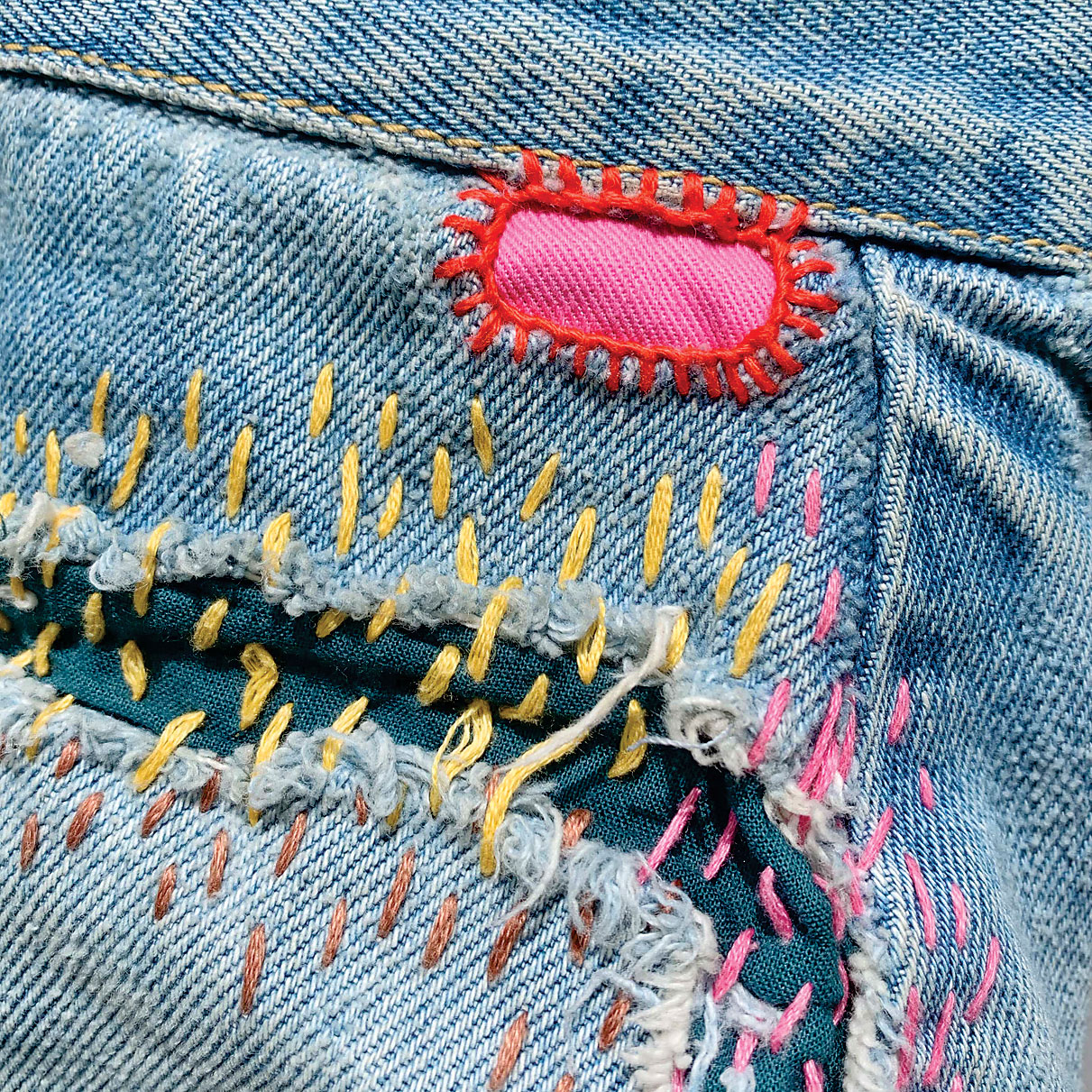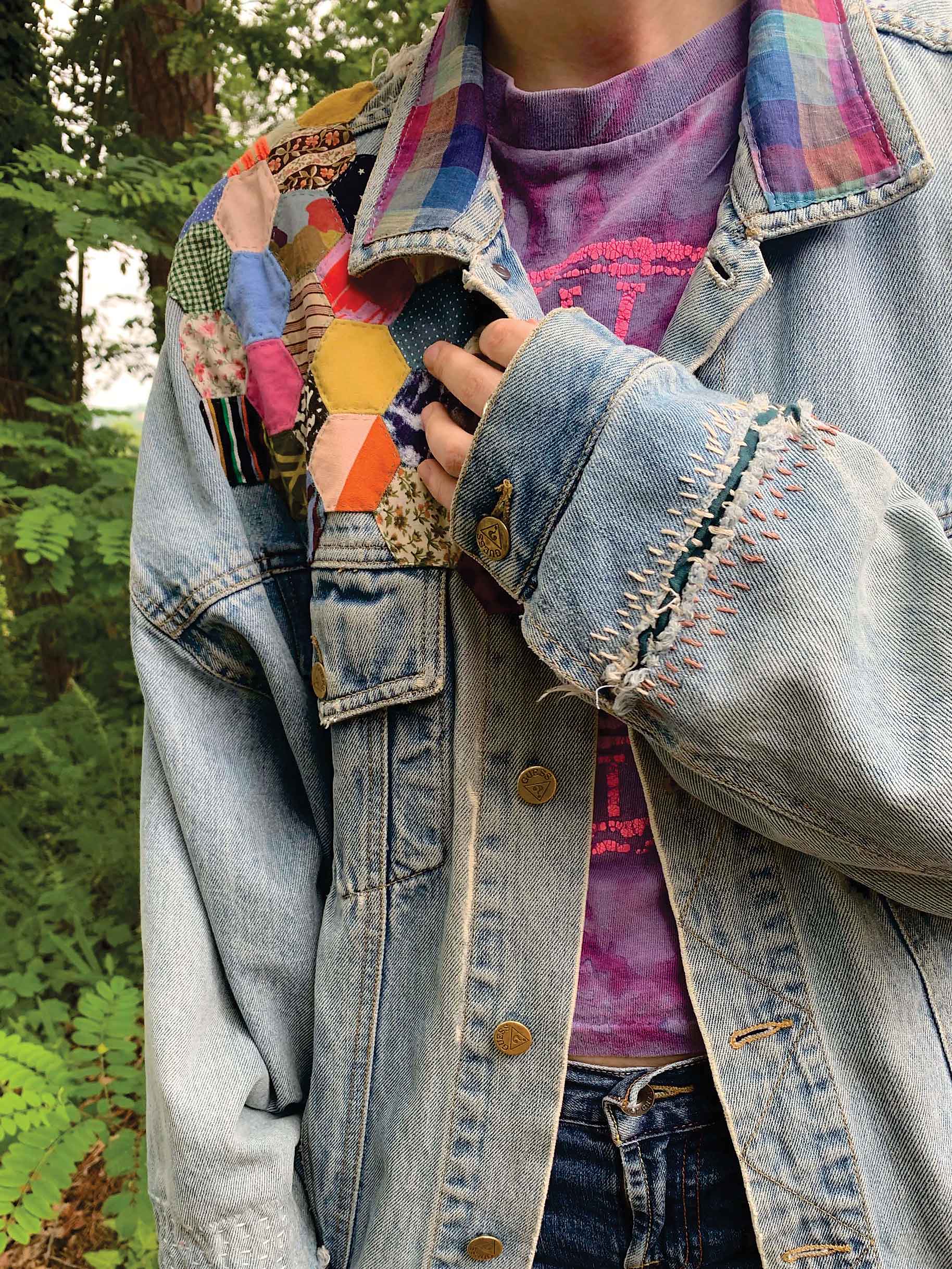Beauty After Damage: Visible Mending
Beauty After Damage: Visible Mending
↑ Lily Fulop is a designer, writer, and visible mender. She runs the Instagram account @mindful_mending.
Photo: Lily Fulop
Creating a new beauty, honoring an old ethic:
Visible Mending
One of the important ways that conservation and restoration overlap is that both involve repair. Restoration specialists like Brittany Nicole Cox generally want the evidence of their work to fade into the background somewhat, so that viewers can take in a work of art without distraction. But for other artisans old and new, the signs of repair actually add beauty – and an ethical dimension – to textiles.
Earlier this year, the Japan Society in New York presented the exhibition “Boro Textiles: Sustainable Aesthetics,” which featured examples of the mended and re-mended quilts and clothing that Japanese artisans have crafted for centuries. Peasants in Tohoku in northern Japan would embroider, mend, and reuse textiles over and over, adding layers to make them extra warm over time. The fixes also add a quality rooted in one of the most significant traditions of Japanese aesthetics, wabi-sabi, the understated beauty of the aged, the imperfect, the faded. The patchwork of mending subtly contributes animation and unpredictability, too, creating a complex loveliness.
The word “boro” literally means “rag” or “tatters,” but the practice has given rise to its own aesthetic, one adopted by contemporary fashion designers and DIY menders alike. For self-described “mindful menders,” repair creates a kind of visual language that spreads the word about the importance of reuse in the age of climate change.
“[My grandparents’ generation was] more connected to the labor of making and valued things differently because they had experienced scarcity. ‘Make do and mend’ was a popular sentiment at the time.”
~Lily Fulop
Designer and writer Lily Fulop, who runs the @mindful_mending account on Instagram, published Wear, Repair, Repurpose: A Maker’s Guide to Mending and Upcycling Clothes this past spring. She teaches readers techniques that they might not have even heard of, even if their great-grandparents were likely experts: darning socks, hemming pants, crocheting pillows, braiding rugs, and embroidering over stains and imperfections.
Wartime and Depression-era austerity made creative reuse and careful repair simple necessities of life. “[M]y grandparents’ generation approached consumption much differently, as a result of experiencing the Great Depression and rationing of World War II and growing up before goods were mass produced so cheaply – and so far away,” Fulop says. “They were more connected to the labor of making and valued things differently because they had experienced scarcity. ‘Make do and mend’ was a popular sentiment at the time, which was all about necessity.” Both of Fulop’s grandmothers knitted and crocheted, and her mother sewed clothes and quilted, but they hadn’t encouraged her to explore those skills and were pleasantly surprised by her interest in them. Fulop discovered knitting and sewing with a sense of fun, but it has become her calling. “I took it up as a hobby,” she says. “Now, it’s a form of activism.”

↑ Patchwork and clever stitches not only fix damage and keep clothes out of landfills, they’re also forms of artistic expression.
Photo: Lily Fulop
The accelerating threat of climate change presents a stark challenge when it comes to steering consumers away from waste. With clothing that’s so abundant and inexpensive, taking the time (and developing the skills) to reuse something old can seem hard to justify. Fulop hopes to change that by making mending an outlet for creative inspiration, technical mastery, and the beauty of imperfection.
“I took it up as a hobby,” Fulop says of visible mending. “Now, it’s a form of activism.”
She notes that the limitations caused by the COVID-19 pandemic – from stay-at-home orders to social distancing to the sudden scarcity of certain goods – has had a bracing effect on generations that have relatively little experience with national exercises in austerity. “People value goods in a new way – what is essential, and what isn’t. Plus, many people have lost their sources of income, so they certainly won’t be buying unnecessary products. For those of us still with jobs where we can work from home, we may still have money to buy new clothes, but we have no reason to because we’re not going anywhere.” And, she points out, the art of mending itself is on the rise as more people are turning to sewing and knitting while spending more time at home.
The approaches that these experts take are diverse and distinctive, but they all have in common a commitment to preserving something that has beauty and cultural value and to sharing it with the world. Whether that means people can admire something in a museum or a gallery, wear it or use it again after rescuing it, or be moved to refashion something by hand using a newly acquired skill, the powers inherent in conservation, restoration, and visible mending can be inspiring practices – sources of beauty and, in a special way, of truth.
Do you have a story about mended clothing?
We'd love to hear your thoughts on this story. Send your reactions, reflections, questions, and concerns to [email protected].
Help us share impactful stories like this one
Become an American Craft Council member and support nonprofit craft publishing. You will not only receive our magazine but also help grow the number of lives craft has touched.



